-
Notifications
You must be signed in to change notification settings - Fork 24
Z. REFERENCE
These nodes enable a wide range of mathematical operations and conversions on various value types. They offer capabilities for comparisons, delays, interpolations, unary and binary operations, component swapping, timing control, value generation, and waveform creation. This set of tools is essential for performing complex calculations, synchronizing workflows, and generating dynamic data for various applications.
Evaluates two inputs (A and B) with a specified comparison operators and optional values for successful and failed comparisons. The node performs the specified operation element-wise between corresponding elements of A and B. If the comparison is successful for all elements, it returns the success value; otherwise, it returns the failure value. The node supports various comparison operators such as EQUAL, GREATER_THAN, LESS_THAN, AND, OR, IS, IN, etc.

Introduce pauses in the workflow that accept an optional input to pass through and a timer parameter to specify the duration of the delay. If no timer is provided, it defaults to a maximum delay. During the delay, it periodically checks for messages to interrupt the delay. Once the delay is completed, it returns the input passed to it.

Calculate linear interpolation between two values or vectors based on a blending factor (alpha). The node accepts optional start (IN_A) and end (IN_B) points, a blending factor (FLOAT), and various input types for both start and end points, such as single values (X, Y), 2-value vectors (IN_A2, IN_B2), 3-value vectors (IN_A3, IN_B3), and 4-value vectors (IN_A4, IN_B4). Additionally, you can specify the easing function (EASE) and the desired output type (TYPE). It supports various easing functions for smoother transitions.
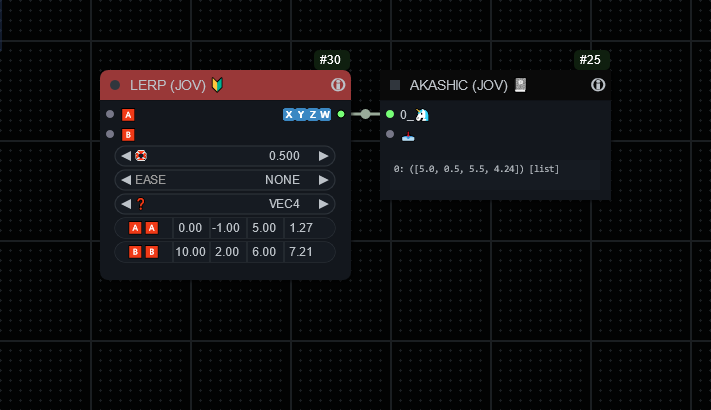
Perform single function operations like absolute value, mean, median, mode, magnitude, normalization, maximum, or minimum on input values.
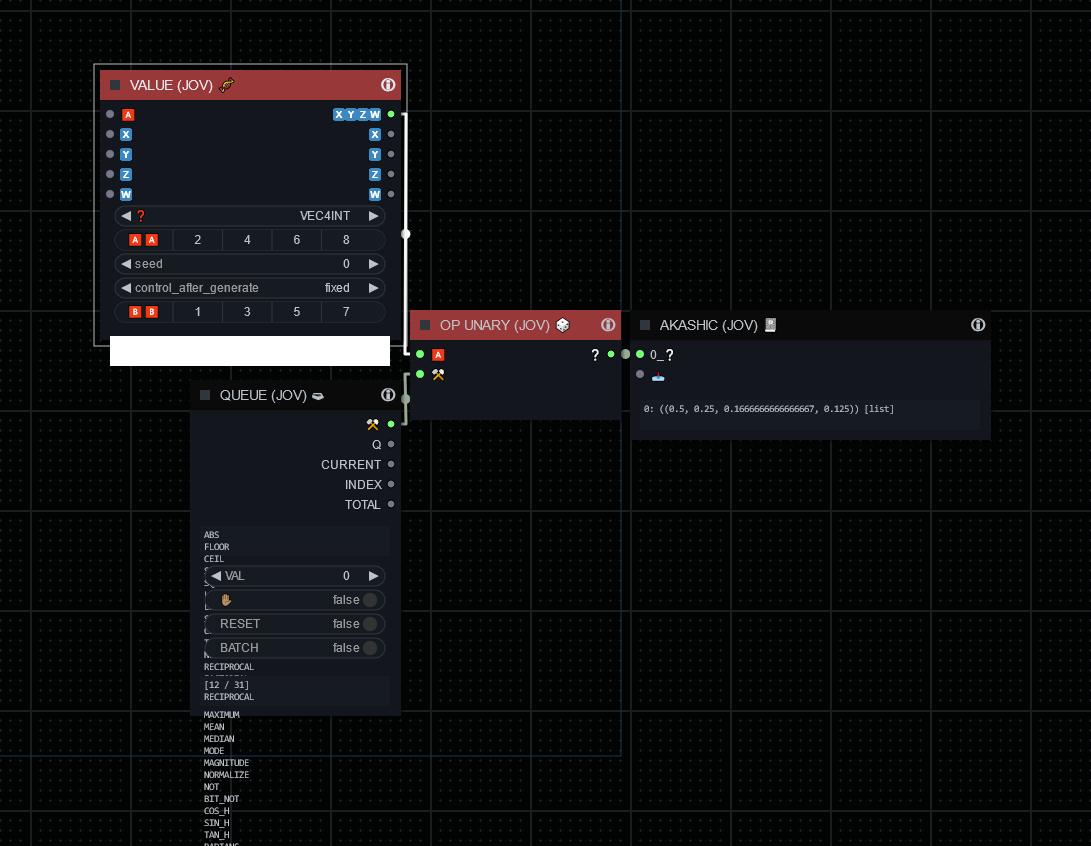
Execute binary operations like addition, subtraction, multiplication, division, and bitwise operations on input values, supporting various data types and vector sizes.
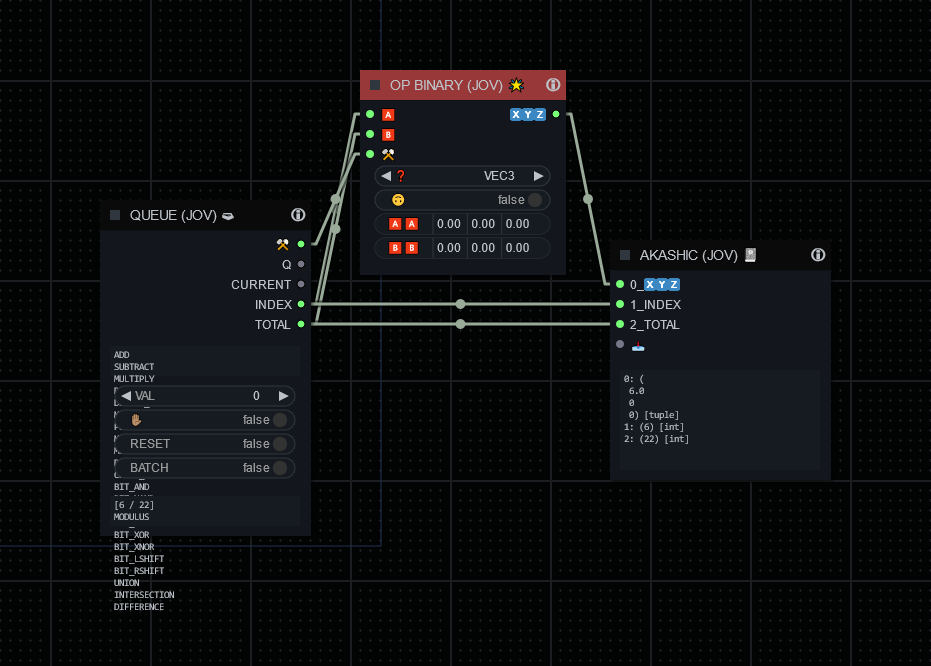
Swap components between two vectors based on specified swizzle patterns and values. It provides flexibility in rearranging vector elements dynamically.
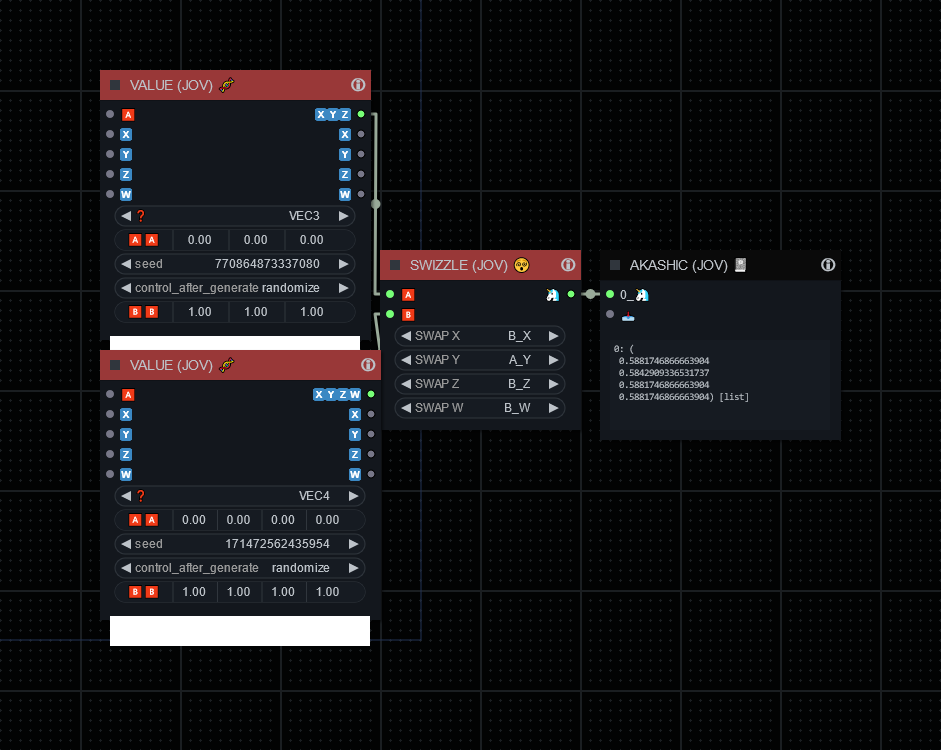
A timer and frame counter, emitting pulses or signals based on time intervals. It allows precise synchronization and control over animation sequences, with options to adjust FPS, BPM, and loop points. This node is useful for generating time-based events or driving animations with rhythmic precision.

Supplies raw or default values for various data types, supporting vector input with components for X, Y, Z, and W. It also provides a string input option.
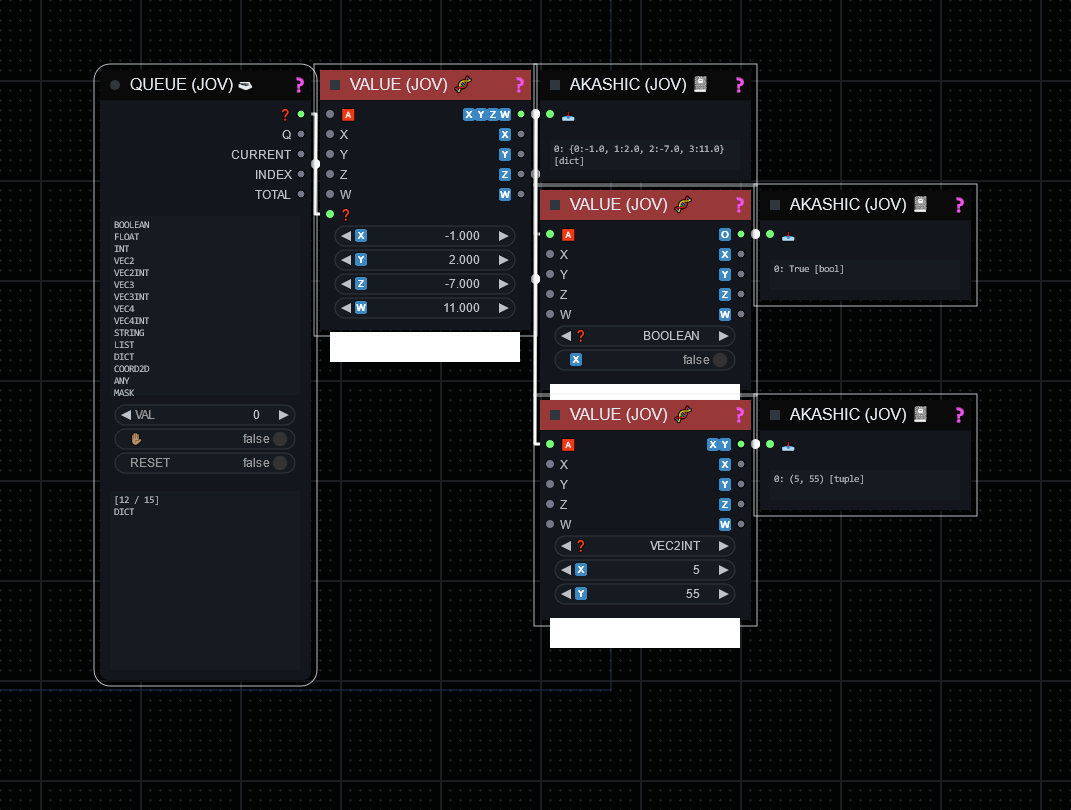
Produce waveforms like sine, square, or sawtooth with adjustable frequency, amplitude, phase, and offset. It's handy for creating oscillating patterns or controlling animation dynamics. This node emits both continuous floating-point values and integer representations of the generated waves.

These nodes provide advanced capabilities for arranging and manipulating visual elements within a frame, allowing for the creation of balanced and harmonious compositions. They enable precise pixel manipulation with various effects, including blending, color adjustments, filtering, and transformations. This suite of tools ensures creative control and flexibility in your image processing workflows.
Enhance and modify images with various effects such as blurring, sharpening, color tweaks, and edge detection. Customize parameters like radius, value, and contrast, and use masks for selective effects. Advanced options include pixelation, quantization, and morphological operations like dilation and erosion. Handle transparency effortlessly to ensure seamless blending of effects. This node is ideal for simple adjustments and complex image transformations.
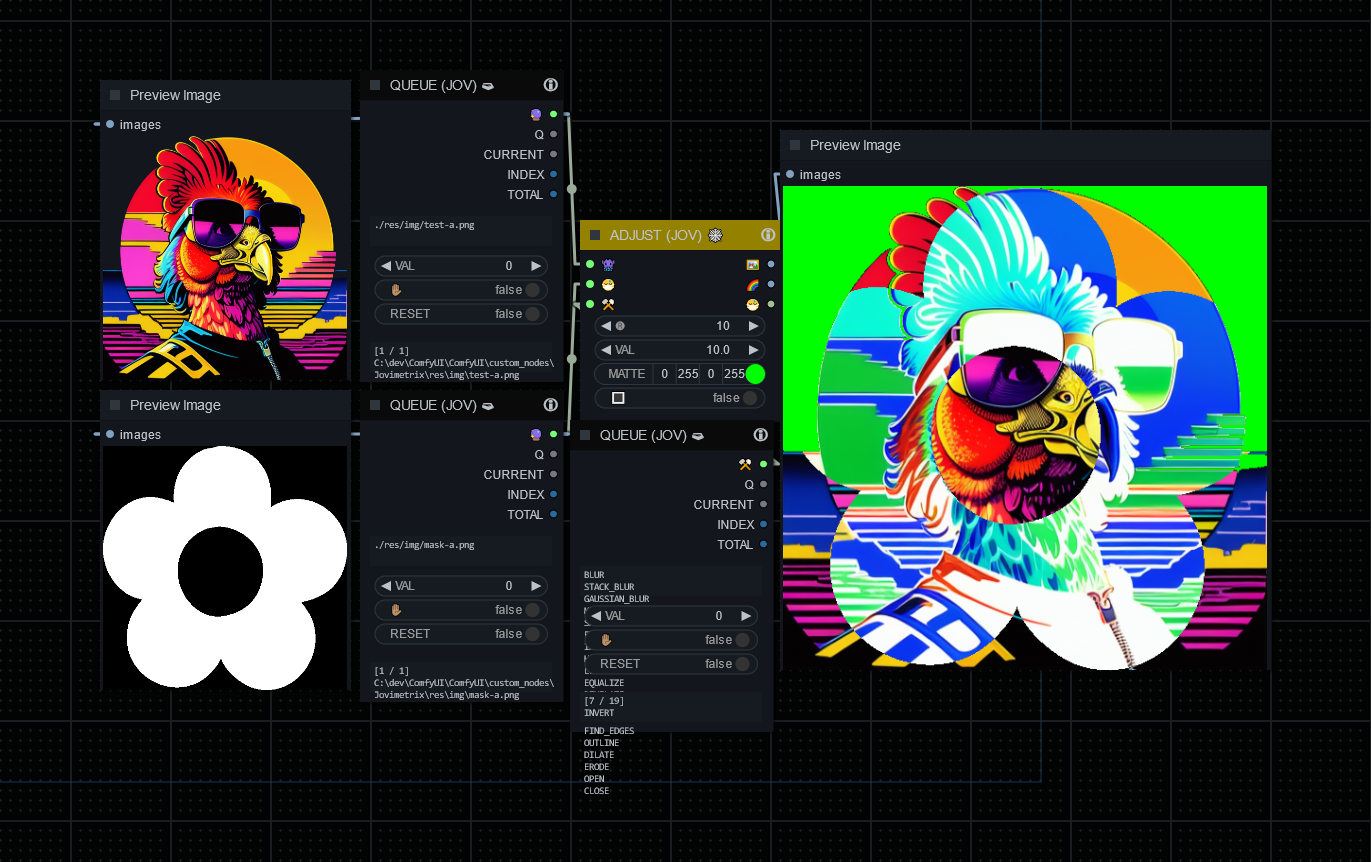
Combine two input images using various blending modes, such as normal, screen, multiply, overlay, etc. It also supports alpha blending and masking to achieve complex compositing effects. This node is essential for creating layered compositions and adding visual richness to images.

Simulate color blindness effects on images. You can select various types of color deficiencies, adjust the severity of the effect, and apply the simulation using different simulators. This node is ideal for accessibility testing and design adjustments, ensuring inclusivity in your visual content.
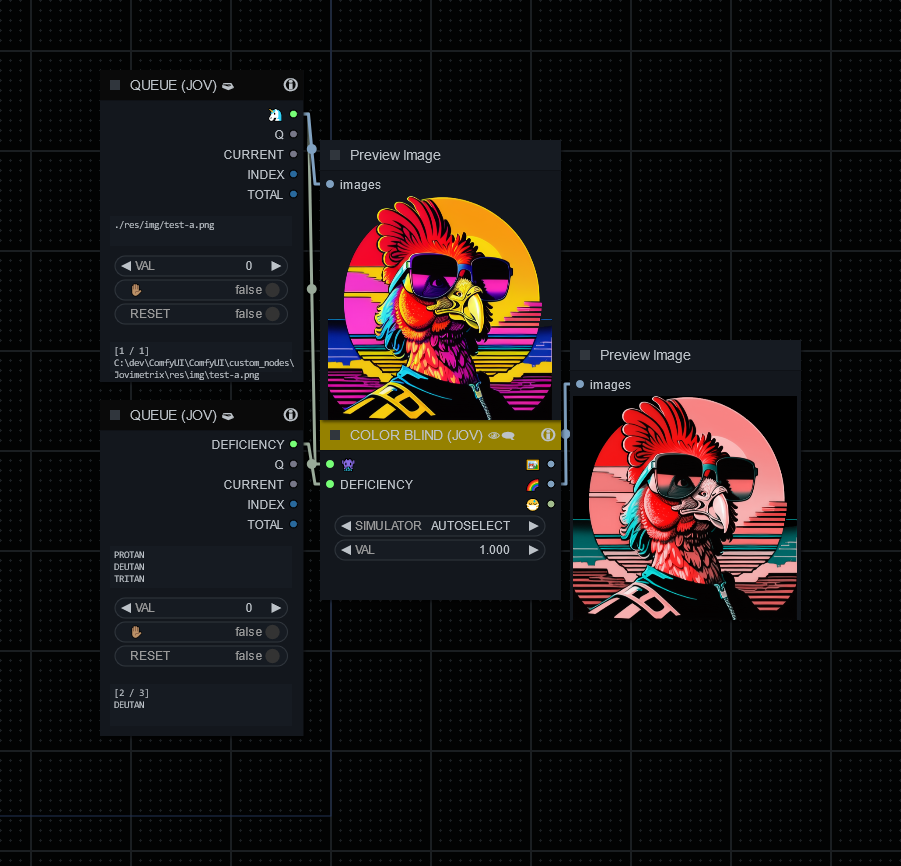
Adjust the color scheme of one image to match another with the Color Match Node. Choose from various color matching modes, including LUT, Histogram, and Reinhard. You can specify options like color maps, the number of colors, and whether to flip or invert the images. This node allows for the creation of seamless and cohesive visuals, making it ideal for texture work or masking in motion graphics and design projects.
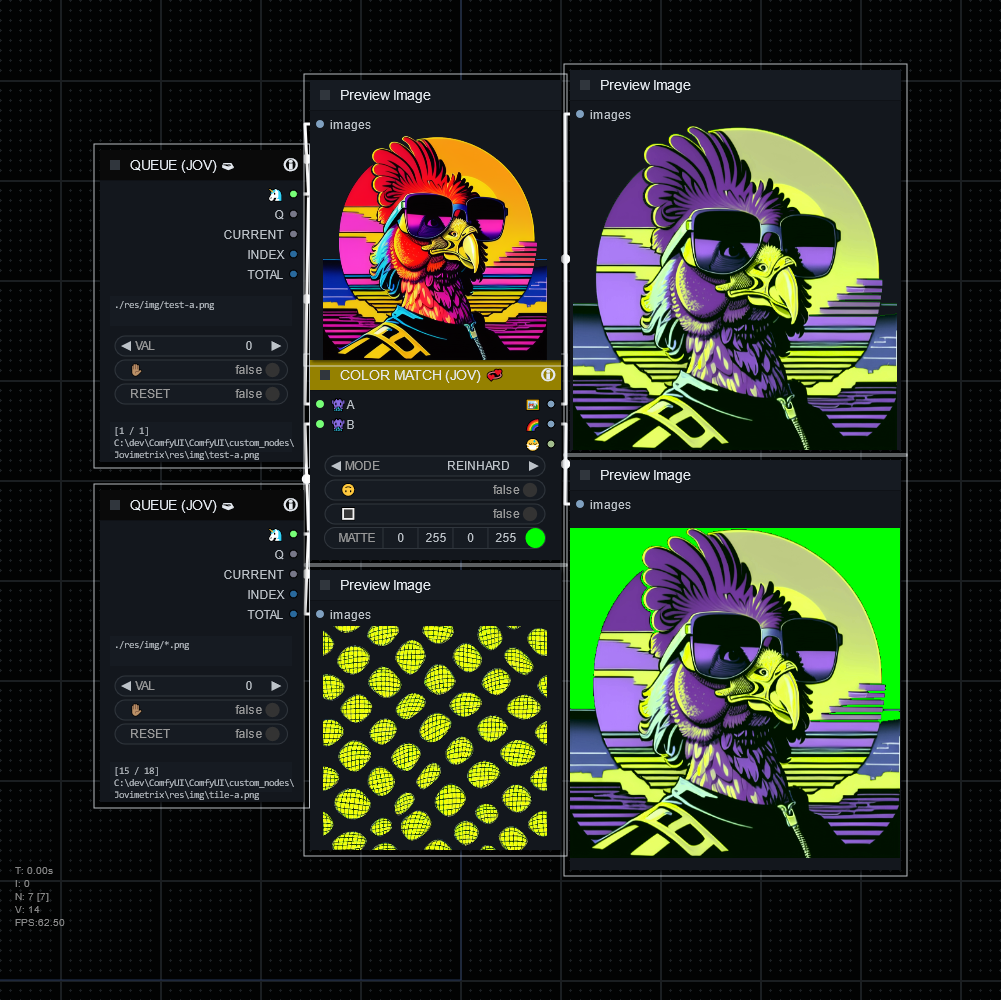
Generate a color harmony based on the selected scheme. Supported schemes include complimentary, analogous, triadic, tetradic, and more. Users can customize the angle of separation for color calculations, offering flexibility in color manipulation and exploration of different color palettes.

Extract a portion of an input image or resize it. It supports various cropping modes, including center cropping, custom XY cropping, and free-form polygonal cropping. This node is useful for preparing image data for specific tasks or extracting regions of interest.

The Filter Mask node allows you to create masks based on color ranges within an image, ideal for selective filtering and masking tasks. You can specify the color range using start and end values along with an optional fuzziness factor to adjust the range. This node provides flexibility in defining precise color-based masks for various image processing applications.
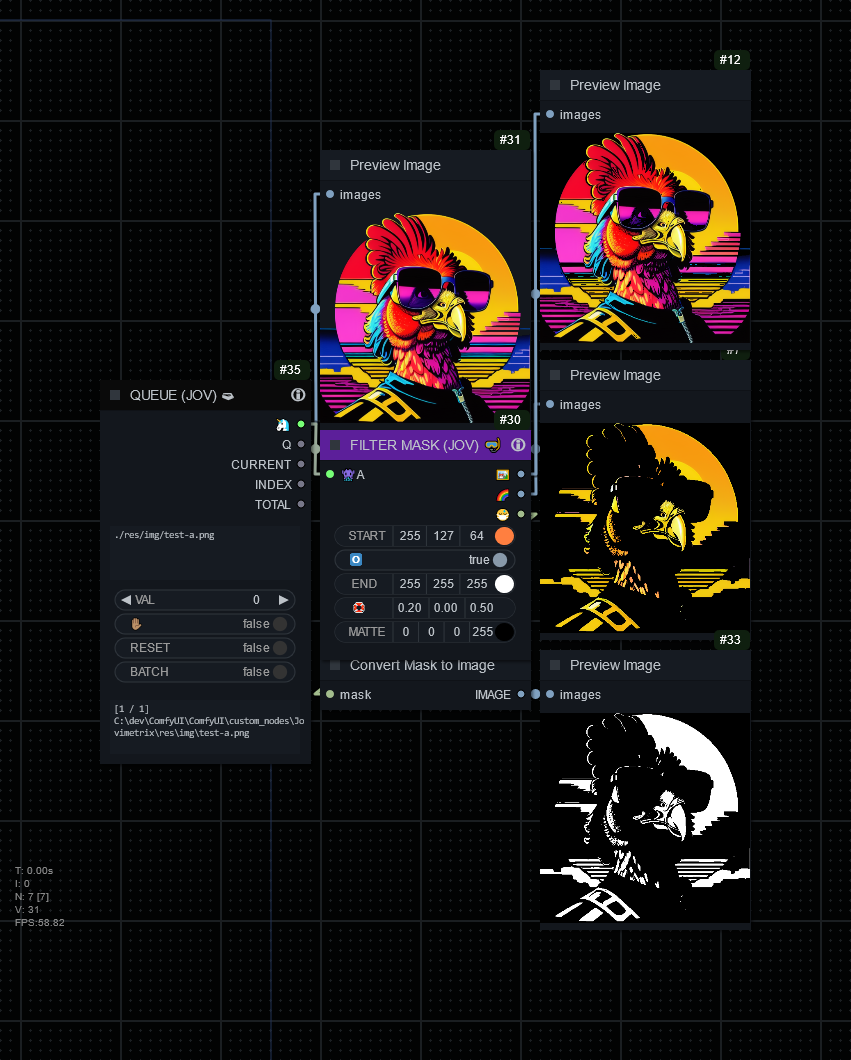
Combine multiple input images into a single image by summing their pixel values. This operation is useful for merging multiple layers or images into one composite image, such as combining different elements of a design or merging masks. Users can specify the blending mode and interpolation method to control how the images are combined. Additionally, a matte can be applied to adjust the transparency of the final composite image.

Remaps an input image using a gradient lookup table (LUT) to allow precise control over color mapping by applying the gradient to the input image. The gradient image will be translated into a single row lookup table. This node is useful for artistic effects, color grading, and mapping specific color ranges to achieve desired visual effects.

Combines individual color channels (red, green, blue) along with an optional mask channel to create a composite image. This node is useful for merging separate color components into a single image for visualization or further processing.
![]()
Takes an input image and splits it into its individual color channels (red, green, blue), along with a mask channel. This node is useful for separating different color components of an image for further processing or analysis.
![]()
Swap pixel values between two input images based on specified channel swizzle operations. Options include pixel inputs, swap operations for red, green, blue, and alpha channels, and constant values for each channel. The swap operations allow for flexible pixel manipulation by determining the source of each channel in the output image, whether it be from the first image, the second image, or a constant value.
![]()
Merge multiple input images into a single composite image by stacking them along a specified axis. Options include axis, stride, scaling mode, width and height, interpolation method, and matte color. The axis parameter allows for horizontal, vertical, or grid stacking of images, while stride controls the spacing between them.

Define a range and apply it to an image for segmentation and feature extraction. Choose from various threshold modes, such as binary and adaptive, and adjust the threshold value and block size to suit your needs. You can also invert the resulting mask if necessary. This node is versatile for a variety of image processing tasks.
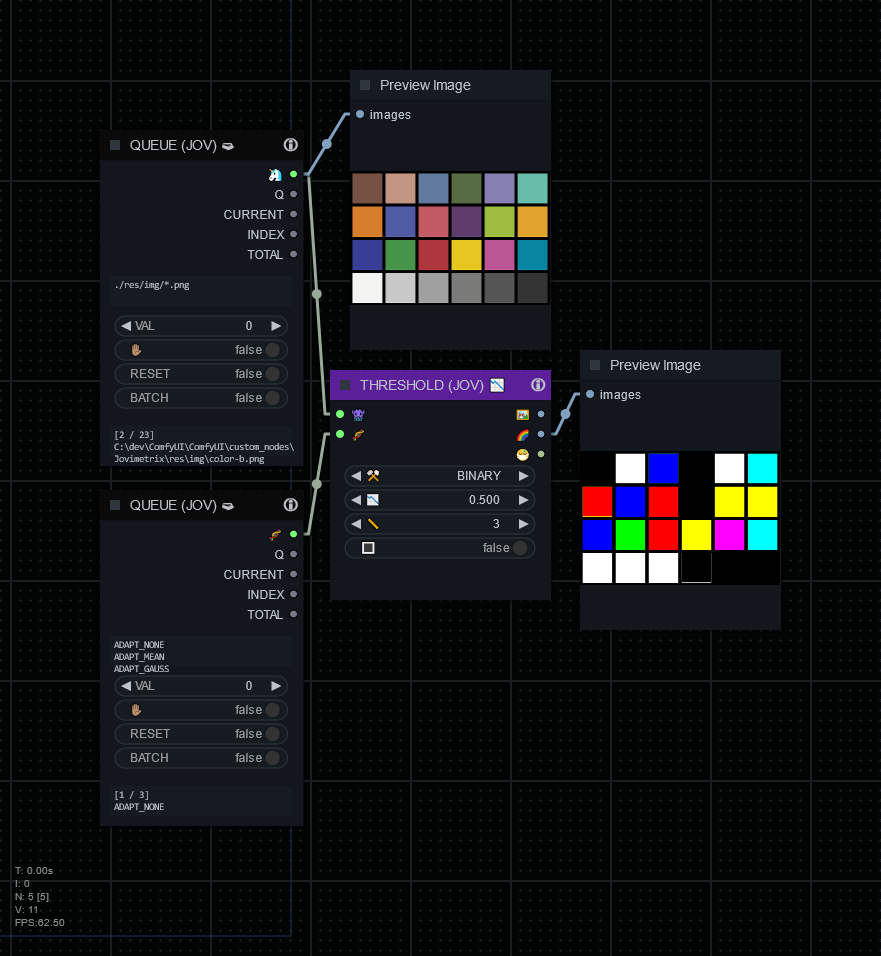
Apply various geometric transformations to images, including translation, rotation, scaling, mirroring, tiling and perspective projection. It offers extensive control over image manipulation to achieve desired visual effects.

These nodes enable the creation of diverse shapes, images, and masks with customizable parameters. They offer precise control over dimensions, colors, and effects. This ensures flexibility and accuracy in your image processing workflows.
Generate a constant image or mask of a specified size and color. It can be used to create solid color backgrounds or matte images for compositing with other visual elements. The node allows you to define the desired width and height of the output and specify the RGBA color value for the constant output. Additionally, you can input an optional image to use as a matte with the selected color.

Execute custom GLSL (OpenGL Shading Language) fragment shaders to generate images or apply effects. GLSL is a high-level shading language used for graphics programming, particularly in the context of rendering images or animations. This node allows for real-time rendering of shader effects, providing flexibility and creative control over image processing pipelines. It takes advantage of GPU acceleration for efficient computation, enabling the rapid generation of complex visual effects.

Create n-sided polygons. These shapes can be customized by adjusting parameters such as size, color, position, rotation angle, and edge blur. The node provides options to specify the shape type, the number of sides for polygons, the RGBA color value for the main shape, and the RGBA color value for the background. Additionally, you can control the width and height of the output images, the position offset, and the amount of edge blur applied to the shapes.

Generates false perception 3D images from 2D input. Set tile divisions, noise, gamma, and shift parameters to control the stereogram's appearance.

Simulates depth perception in images by generating stereoscopic views. It accepts an optional input image for color matte. Adjust baseline and focal length for customized depth effects.

Generates images containing text based on parameters such as font, size, alignment, color, and position. Users can input custom text messages, select fonts from a list of available options, adjust font size, and specify the alignment and justification of the text. Additionally, the node provides options for auto-sizing text to fit within specified dimensions, controlling letter-by-letter rendering, and applying edge effects such as clipping and inversion.

Visualizes audio waveforms as bars. Adjust parameters like the number of bars, bar thickness, and colors.

These nodes facilitate the loading and processing of multimedia data from various sources, including system cameras, monitors, and URL resources. They provide robust tools for capturing, filtering, and streaming MIDI and video data. This ensures comprehensive control and flexibility for integrating multimedia elements into your projects.
Captures MIDI messages from an external MIDI device or controller. It monitors MIDI input and provides information about the received MIDI messages, including whether a note is being played, the MIDI channel, control number, note number, value, and a normalized value. This node is essential for integrating MIDI control into various applications, such as music production, live performances, and interactive installations.
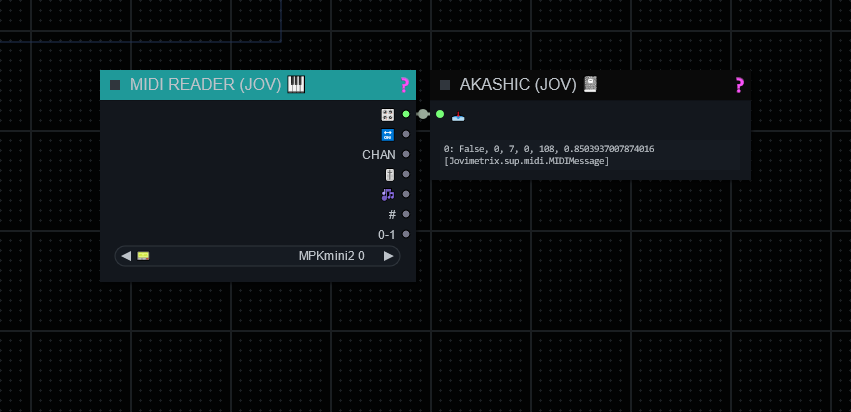
Processes MIDI messages received from an external MIDI controller or device. It accepts MIDI messages as input and returns various attributes of the MIDI message, including whether the message is valid, the MIDI channel, control number, note number, value, and normalized value. This node is useful for integrating MIDI control into creative projects, allowing users to respond to MIDI input in real-time.
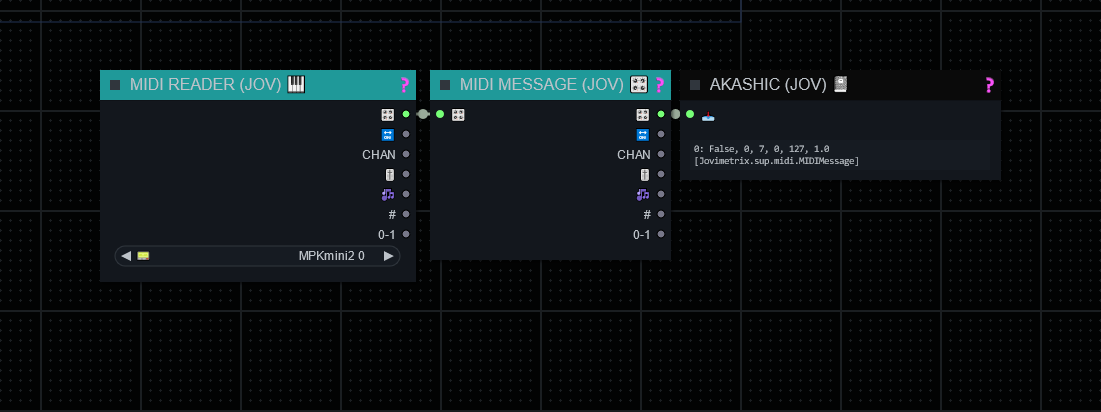
Provides advanced filtering capabilities for MIDI messages based on various criteria, including MIDI mode (such as note on or note off), MIDI channel, control number, note number, value, and normalized value. It allows you to filter out unwanted MIDI events and selectively process only the desired ones. This node offers flexibility in MIDI data processing, enabling precise control over which MIDI messages are passed through for further processing.
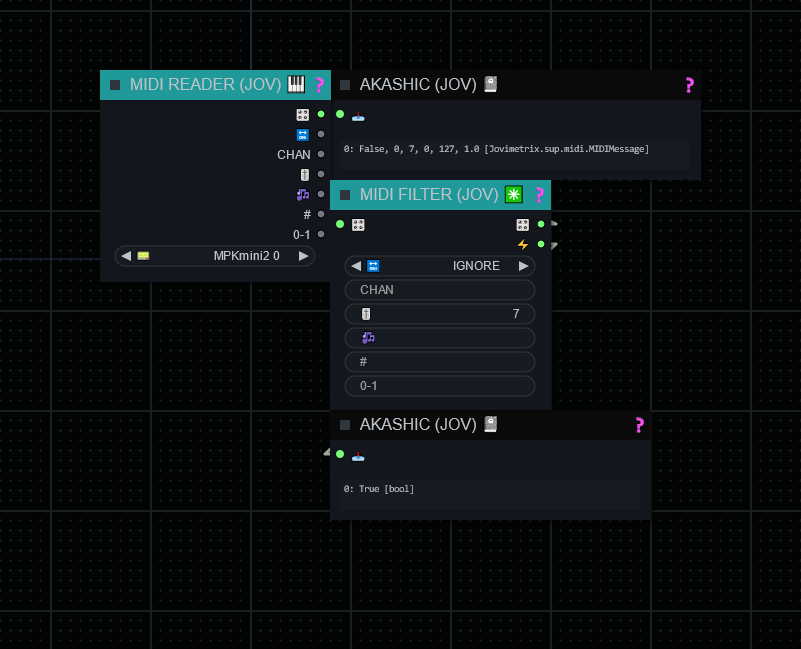
Filter MIDI messages based on various criteria, including MIDI mode (such as note on or note off), MIDI channel, control number, note number, value, and normalized value. This node is useful for processing MIDI input and selectively passing through only the desired messages. It helps simplify MIDI data handling by allowing you to focus on specific types of MIDI events.
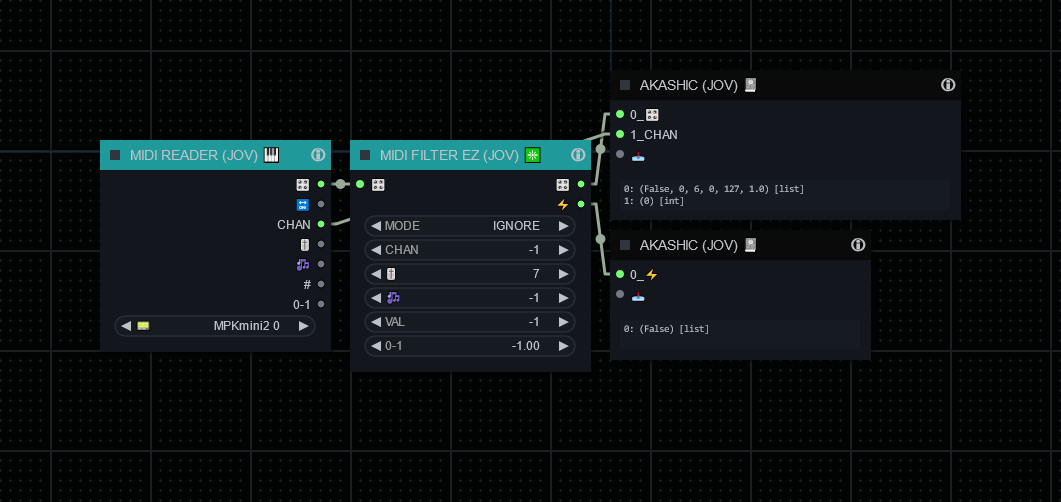
Sends frames to a specified Spout receiver application for real-time video sharing. Accepts tensors representing images and allows configuration of parameters such as the Spout host, frame rate, resolution, scaling mode, interpolation method, and matte color. The node continuously streams frames to the specified Spout host, enabling real-time visualization or integration with other applications that support Spout.
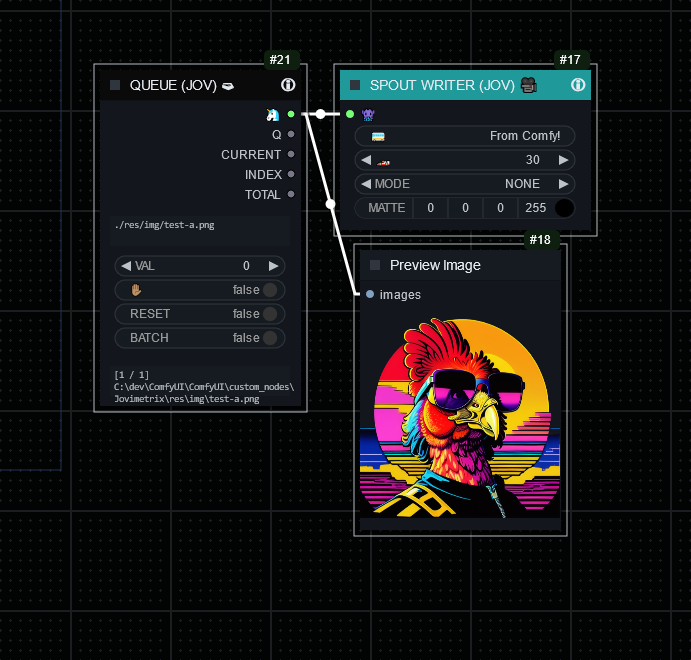
Capture frames from various sources such as URLs, cameras, monitors, windows, or Spout streams. It supports batch processing, allowing multiple frames to be captured simultaneously. The node provides options for configuring the source, resolution, frame rate, zoom, orientation, and interpolation method. Additionally, it supports capturing frames from multiple monitors or windows simultaneously. The captured frames are returned as tensors, enabling further processing downstream.
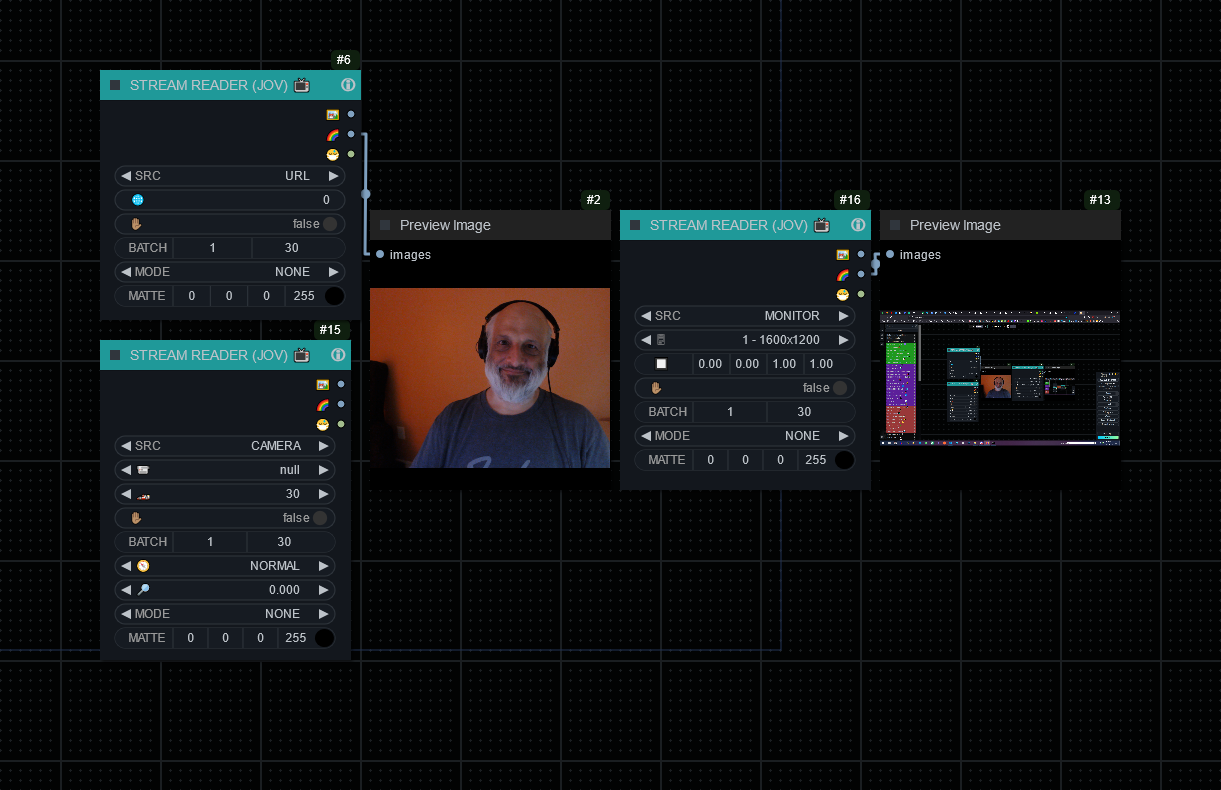
Sends frames to a specified route, typically for live streaming or recording purposes. It accepts tensors representing images and allows configuration of parameters such as route, resolution, scaling mode, interpolation method, and matte color. The node continuously streams frames to the specified route, enabling real-time visualization or recording of processed video data.
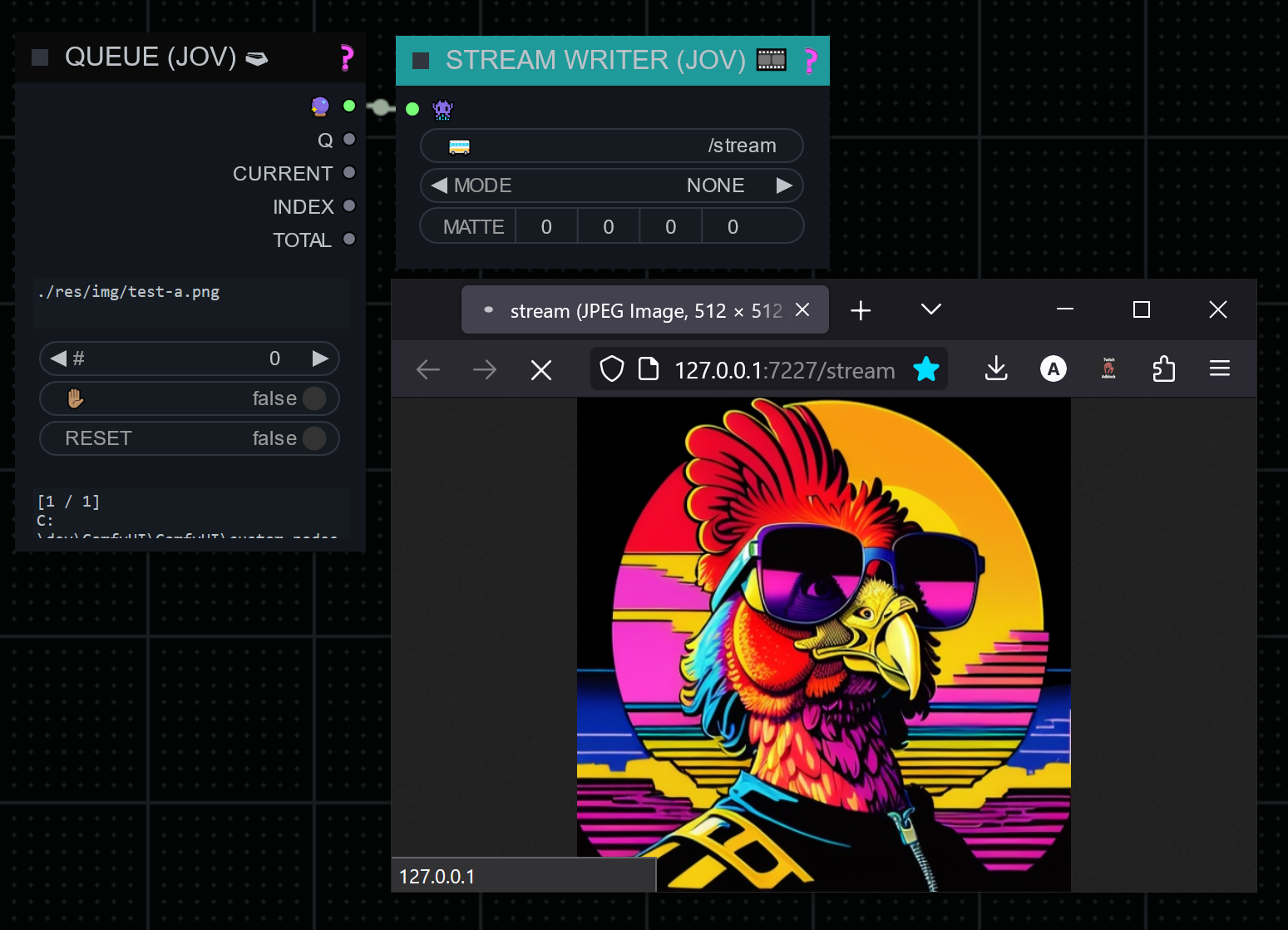
These nodes enable comprehensive data visualization, processing, and management. They support various operations such as visualizing data, processing arrays, exporting media, graphing data points, managing queues, routing data, and saving output with metadata. This suite of tools ensures efficient handling and analysis of multimedia and data-driven projects.
Visualize data. It accepts various types of data, including images, text, and other types. If no input is provided, it returns an empty result. The output consists of a dictionary containing UI-related information, such as base64-encoded images and text representations of the input data.

Processes a batch of data based on the selected mode, such as merging, picking, slicing, random selection, or indexing. Allows for flipping the order of processed items and dividing the data into chunks.

Responsible for saving images or animations to disk. It supports various output formats such as GIF and GIFSKI. Users can specify the output directory, filename prefix, image quality, frame rate, and other parameters. Additionally, it allows overwriting existing files or generating unique filenames to avoid conflicts. The node outputs the saved images or animation as a tensor.

Visualize a series of data points over time. It accepts a dynamic number of values to graph and display, with options to reset the graph or specify the number of values. The output is an image displaying the graph, allowing users to analyze trends and patterns.

Manage a queue of items, such as file paths or data. It supports various formats including images, videos, text files, and JSON files. Users can specify the current index for the queue item, enable pausing the queue, or reset it back to the first index. The node outputs the current item in the queue, the entire queue, the current index, and the total number of items in the queue.

Routes the input data from the optional input ports to the output port, preserving the order of inputs. The PASS_IN optional input is directly passed through to the output, while other optional inputs are collected and returned as tuples, preserving the order of insertion.

Save the output image along with its metadata to the specified path. Supports saving additional user metadata and prompt information.

| DONATIONS | HELP |
|---|---|
   
|
|
Code, Discussion or Monetary Contributions are most welcome.
This project is licensed under the MIT License. See the LICENSE file for details.